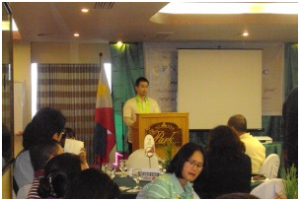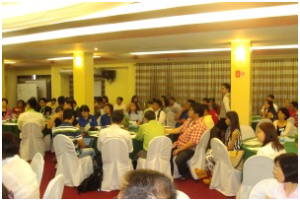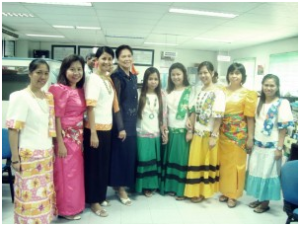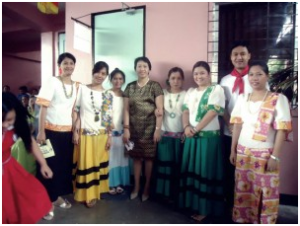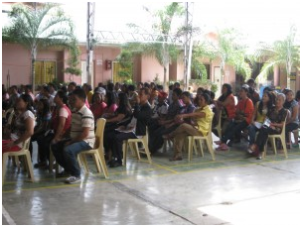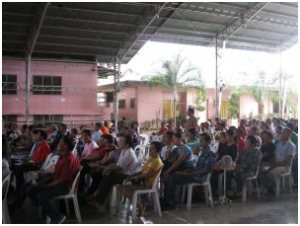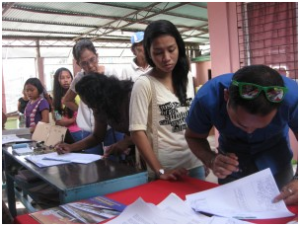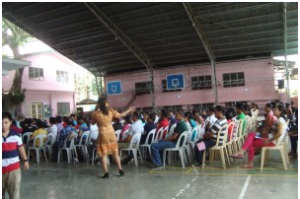January 15, 2013 Minister Keizo Takekawa, Head of the Political Section of the Embassy of Japan based in Manila visited PNJK compound. He was accompanied by the former Deputy Director and Consul Hon. Kazuhiko Anzai and the current Director and Consul Koichi Ibara, Japanese Consulate Office in Davao City;
February 17, 2013 was the General Assembly of PNJK Multipurpose Cooperative. Elected Board Members are: Mr. Rodrigo M. Suemitsu – Chairman (Certified Public Accountant), Juseven T. Austero – Vice Chairman, Mrs. Ines P. Mallari, Mrs. Elizabeth M. Tagud and Mr. Felipe C. Hiquial, Jr. as Directors;

February 23, 2013 – PNJK Inc. and JPIC joint meeting held at MKD Audio Visual Room. Present: Hideo Ito – President, Chokichi Hoshi, Vice President and officers Shinobu Murakami, Yoshihiro Tokumitsu and others;
May 16, 2013 was the 33rd PNJK General Assembly and election. Officers: Chairman – Rev. Bernardo N. Fernandez, Sr., Ret. Judge Antonina B. Escovilla – President, Mrs. Ines P. Mallari – 1st Vice President, Juseven Austero – 2nd Vice President, Corporate Secretary Nelma N. Adachi, Asst. Corporate Secretary Carmen C. Apigo, Treasurer Anita P. Iwamoto, Auditor Rodrigo M. Suemitsu, P.I.O Elizabeth Tagud, Felipe C. Hiquial, Jr. and Adelaida S. Panaguiton as Directors. Oathtaking was before Hon. Koichi Ibara. We discussed and currently implementing the Mortuary Aide Program. This was disseminated to all members who were not in attendance during the General Assembly and those who are in Japan.
July 28, 2013 the Okinawa group headed by Mr. Gentaru Nakamura about 80 of them visited Davao City. Some PNJK Officials joined the Iresai at Mintal Cemetery, Wireless Public Cemetery, Tamugan Shrine and Lubogan Public Cemetery.

August 15, 2013 is the yearly Ireisai, the event was jointly sponsored by PNJK Inc. and the Consulate Office of Japan in Davao. Most of the Japanese residing in Davao participated in the floral offering.
September 17, 2013 the second PNJK Inc. and JPIC joint meeting. Reports regarding descendants who are doing well in Japan were heard including those who left the company. Financial reports were likewise discussed.
September 25, 2013 – Met Mr. Inomata and Atty. Zuniega with Mrs. Obuchi, Federation President Ines P. Mallari and PNJK President on legal concern such as the issuance of passports and travel documents.


October 2 to 5 2013 was our yearly Philippine Japan Festival. Ambassador Toshinao Urabe graced such occasion and took time to give lecture to the college students as well as students from universities and colleges in Davao City. The Consuls from Malaysia and Indonesia likewise attended the affair. Cultural lessons like ikebana, tea ceremony, wearing of kimono, use of Chopsticks, sumo and karate demonstrations were part of the celebration as well musical and cultural dances. Japanese speech contest participated in by contestants from other schools was held.
During that occasion our college was a recipient of certificate of Commendation from the Ministry of Foreign Affairs Minister Fumio Kishida that was handed to MKD President Ines P. Mallari by His Excellency Ambassador Toshinao Urabe for promoting Japanese Language in Davao City.
October 5, 2013 – Kichijoji Lions Club Officials came and supported our Ensemble Recorder Competition headed by former Presidents Kiyohito Takigawa and Atty. Hideshige Aoki.
October 18 to 26, 2013 The Federation President Ines P. Mallari and PNJK Inc. President Antonina B. Escovilla visited Kagoshima, Shizuoka, Sendai, Fukushima and Tokyo to check and monitor the members of our association. Our members were encouraged to organize themselves so that they can be as strong as the Peruvians and Brazilians who are given a slot during the Kigyo kyokai Tai to present their accomplishment. If our descendants would be able to group themselves they can convey to the Japanese government their sentiments, appeals of whatever nature not only to be recognized as Japanese descendants but enjoy privileges which pure Japanese are enjoying.
October 27, 2013 in Davao City, we met the President of Nippon Foundation, Mr. Takeju Ogata who was responsible in giving the association the grant that paved the way to the erection of the Polyclinic building. All our colleagues in the Board were around to meet President Ogata despite the fact that it was a Holiday, being Barangay Election. Reports were presented to him as to the progress of the laboratory services, the list of occupants of the building, the number of patients that availed of the medical services as well as financial reports.
November 03, 2013 PNJK officials attended the 10th Anniversary of Philippine Nikkei Jin Legal Support Center. Present were some lawyers from Japan who handled our shuseki petitions filed before the Family Court in Japan. On that occasion, the Federation and PNJK handed plaques of appreciation to lawyers who appeared before the Family Court. On record from 2004 to the present we have 31 approved shuseki petitions including upgrading of families from Cat. B to Cat. A. Part of the 31 are two Miyata Ushita families from San Carlos, Cebu.
November 12, 2013 Mr. Akira Shibasaki and Kazuaki Nakada of the R & D Japanese Research Company commissioned by the Nippon Foundation came to conduct research on the descendants whose shuseki petitions were approved as well as inquiring as to the number of descendants who are members of the association, their whereabouts as well as records of those due for shuseki petitions.
Appeal to all: Remain loyal to the association. Cooperate in all activities and take note of your responsibilities to the association. Continue your patronage as the success of the association is the success of everyone. Thank you.



